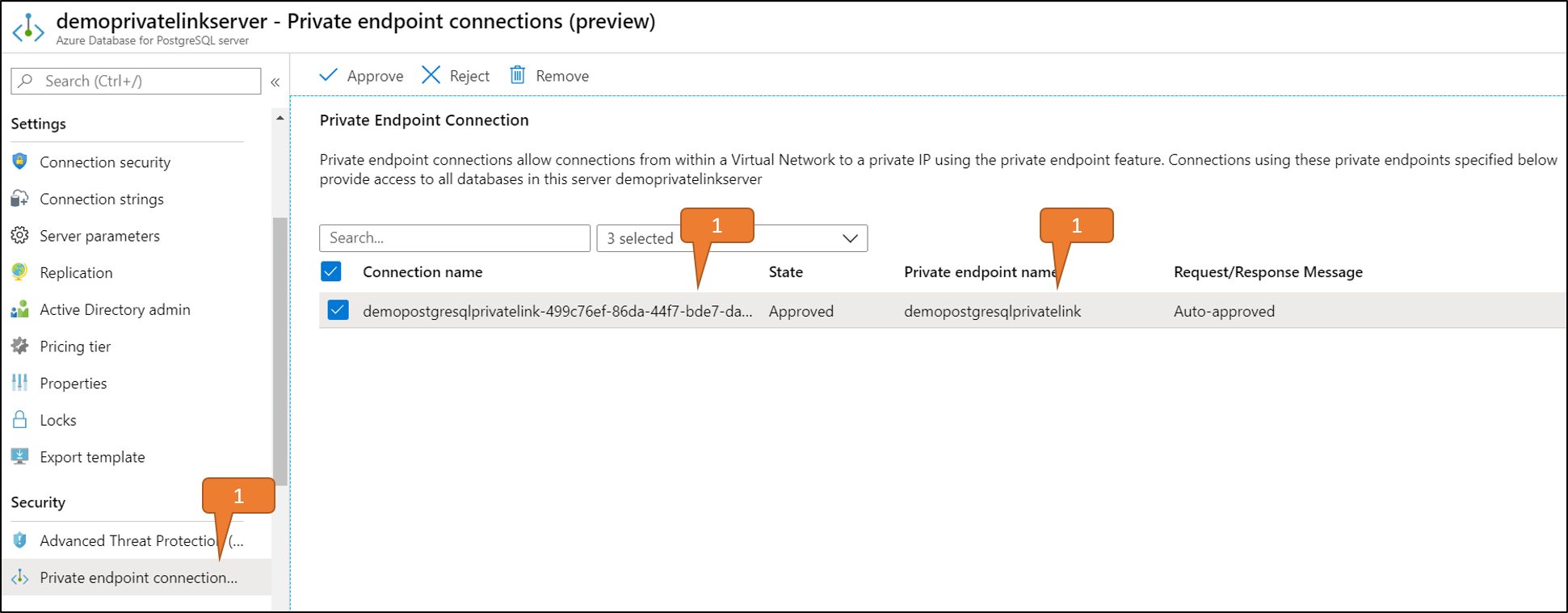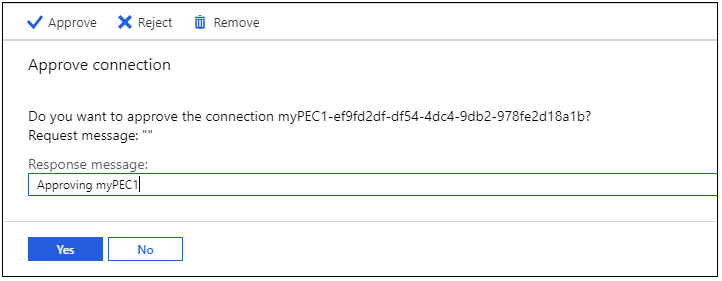Private Link for Azure Database for PostgreSQL-Single server
APPLIES TO:  Azure Database for PostgreSQL - Single Server
Azure Database for PostgreSQL - Single Server
Important
Azure Database for PostgreSQL - Single Server is on the retirement path. We strongly recommend that you upgrade to Azure Database for PostgreSQL - Flexible Server. For more information about migrating to Azure Database for PostgreSQL - Flexible Server, see What's happening to Azure Database for PostgreSQL Single Server?.
Private Link allows you to create private endpoints for Azure Database for PostgreSQL - Single server to bring it inside your Virtual Network (VNet). The private endpoint exposes a private IP within a subnet that you can use to connect to your database server just like any other resource in the VNet.
For a list to PaaS services that support Private Link functionality, review the Private Link documentation. A private endpoint is a private IP address within a specific VNet and Subnet.
Note
The private link feature is only available for Azure Database for PostgreSQL servers in the General Purpose or Memory Optimized pricing tiers. Ensure the database server is in one of these pricing tiers.
Data exfiltration prevention
Data ex-filtration in Azure Database for PostgreSQL Single server is when an authorized user, such as a database admin, is able to extract data from one system and move it to another location or system outside the organization. For example, the user moves the data to a storage account owned by a third party.
Consider a scenario with a user running PGAdmin inside an Azure Virtual Machine (VM) that is connecting to an Azure Database for PostgreSQL Single server provisioned in West US. The example below shows how to limit access with public endpoints on Azure Database for PostgreSQL Single server using network access controls.
Disable all Azure service traffic to Azure Database for PostgreSQL Single server via the public endpoint by setting Allow Azure Services to OFF. Ensure no IP addresses or ranges are allowed to access the server either via firewall rules or virtual network service endpoints.
Only allow traffic to the Azure Database for PostgreSQL Single server using the Private IP address of the VM. For more information, see the articles on Service Endpoint and VNet firewall rules.
On the Azure VM, narrow down the scope of outgoing connection by using Network Security Groups (NSGs) and Service Tags as follows
- Specify an NSG rule to allow traffic for Service Tag = SQL.WestUS - only allowing connection to Azure Database for PostgreSQL Single server in West US
- Specify an NSG rule (with a higher priority) to deny traffic for Service Tag = SQL - denying connections to PostgreSQL Database in all regions
At the end of this setup, the Azure VM can connect only to Azure Database for PostgreSQL Single server in the West US region. However, the connectivity isn't restricted to a single Azure Database for PostgreSQL Single server. The VM can still connect to any Azure Database for PostgreSQL Single server in the West US region, including the databases that aren't part of the subscription. While we've reduced the scope of data exfiltration in the above scenario to a specific region, we haven't eliminated it altogether.
With Private Link, you can now set up network access controls like NSGs to restrict access to the private endpoint. Individual Azure PaaS resources are then mapped to specific private endpoints. A malicious insider can only access the mapped PaaS resource (for example an Azure Database for PostgreSQL Single server) and no other resource.
On-premises connectivity over private peering
When you connect to the public endpoint from on-premises machines, your IP address needs to be added to the IP-based firewall using a Server-level firewall rule. While this model works well for allowing access to individual machines for dev or test workloads, it's difficult to manage in a production environment.
With Private Link, you can enable cross-premises access to the private endpoint using Express Route (ER), private peering or VPN tunnel. They can subsequently disable all access via public endpoint and not use the IP-based firewall.
Note
In some cases the Azure Database for PostgreSQL and the VNet-subnet are in different subscriptions. In these cases you must ensure the following configurations:
- Make sure that both the subscription has the Microsoft.DBforPostgreSQL resource provider registered.
Configure Private Link for Azure Database for PostgreSQL Single server
Creation Process
Private endpoints are required to enable Private Link. This can be done using the following how-to guides.
Approval Process
Once the network admin creates the private endpoint (PE), the PostgreSQL admin can manage the private endpoint Connection (PEC) to Azure Database for PostgreSQL. This separation of duties between the network admin and the DBA is helpful for management of the Azure Database for PostgreSQL connectivity.
- Navigate to the Azure Database for PostgreSQL server resource in the Azure portal.
- Select the private endpoint connections in the left pane
- Shows a list of all private endpoint Connections (PECs)
- Corresponding private endpoint (PE) created

- Select an individual PEC from the list by selecting it.

- The PostgreSQL server admin can choose to approve or reject a PEC and optionally add a short text response.

- After approval or rejection, the list will reflect the appropriate state along with the response text

Use cases of Private Link for Azure Database for PostgreSQL
Clients can connect to the private endpoint from the same VNet, peered VNet in same region or across regions, or via VNet-to-VNet connection across regions. Additionally, clients can connect from on-premises using ExpressRoute, private peering, or VPN tunneling. Below is a simplified diagram showing the common use cases.

Connecting from an Azure VM in Peered Virtual Network (VNet)
Configure VNet peering to establish connectivity to the Azure Database for PostgreSQL - Single server from an Azure VM in a peered VNet.
Connecting from an Azure VM in VNet-to-VNet environment
Configure VNet-to-VNet VPN gateway connection to establish connectivity to an Azure Database for PostgreSQL - Single server from an Azure VM in a different region or subscription.
Connecting from an on-premises environment over VPN
To establish connectivity from an on-premises environment to the Azure Database for PostgreSQL - Single server, choose and implement one of the options:
Private Link combined with firewall rules
The following situations and outcomes are possible when you use Private Link in combination with firewall rules:
If you don't configure any firewall rules, then by default, no traffic will be able to access the Azure Database for PostgreSQL Single server.
If you configure public traffic or a service endpoint and you create private endpoints, then different types of incoming traffic are authorized by the corresponding type of firewall rule.
If you don't configure any public traffic or service endpoint and you create private endpoints, then the Azure Database for PostgreSQL Single server is accessible only through the private endpoints. If you don't configure public traffic or a service endpoint, after all approved private endpoints are rejected or deleted, no traffic will be able to access the Azure Database for PostgreSQL Single server.
Deny public access for Azure Database for PostgreSQL Single server
If you want to rely only on private endpoints for accessing their Azure Database for PostgreSQL Single server, you can disable setting all public endpoints (firewall rules and VNet service endpoints) by setting the Deny Public Network Access configuration on the database server.
When this setting is set to YES only connections via private endpoints are allowed to your Azure Database for PostgreSQL. When this setting is set to NO clients can connect to your Azure Database for PostgreSQL based on your firewall or VNet service endpoint setting. Additionally, once the value of the Private network access is set, customers cannot add and/or update existing 'Firewall rules' and 'VNet service endpoint rules'.
Note
This feature is available in all Azure regions where Azure Database for PostgreSQL - Single server supports General Purpose and Memory Optimized pricing tiers.
This setting does not have any impact on the SSL and TLS configurations for your Azure Database for PostgreSQL Single server.
To learn how to set the Deny Public Network Access for your Azure Database for PostgreSQL Single server from Azure portal, refer to How to configure Deny Public Network Access.
Related content
To learn more about Azure Database for PostgreSQL Single server security features, see the following articles:
To configure a firewall for Azure Database for PostgreSQL Single server, see Firewall support.
To learn how to configure a virtual network service endpoint for your Azure Database for PostgreSQL Single server, see Configure access from virtual networks.
For an overview of Azure Database for PostgreSQL Single server connectivity, see Azure Database for PostgreSQL Connectivity Architecture
Feedback
Coming soon: Throughout 2024 we will be phasing out GitHub Issues as the feedback mechanism for content and replacing it with a new feedback system. For more information see: https://aka.ms/ContentUserFeedback.
Submit and view feedback for